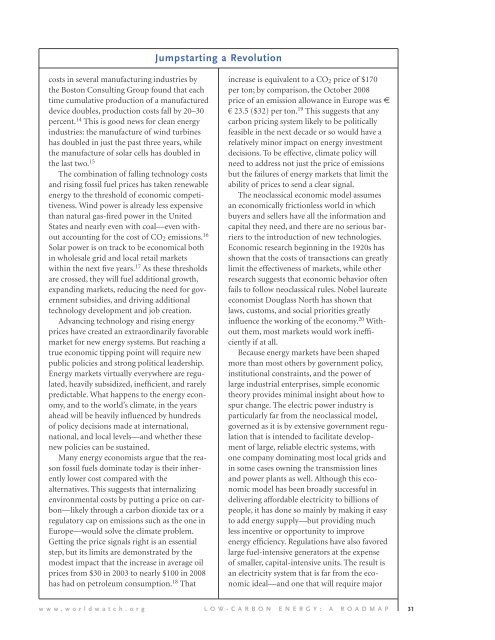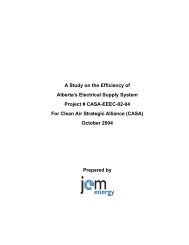Worldwatch Institute
Worldwatch Institute
Worldwatch Institute
Create successful ePaper yourself
Turn your PDF publications into a flip-book with our unique Google optimized e-Paper software.
Jumpstarting a Revolution<br />
costs in several manufacturing industries by<br />
the Boston Consulting Group found that each<br />
time cumulative production of a manufactured<br />
device doubles, production costs fall by 20–30<br />
percent. 14 This is good news for clean energy<br />
industries: the manufacture of wind turbines<br />
has doubled in just the past three years, while<br />
the manufacture of solar cells has doubled in<br />
the last two. 15<br />
The combination of falling technology costs<br />
and rising fossil fuel prices has taken renewable<br />
energy to the threshold of economic competitiveness.<br />
Wind power is already less expensive<br />
than natural gas-fired power in the United<br />
States and nearly even with coal—even without<br />
accounting for the cost of CO 2 emissions. 16<br />
Solar power is on track to be economical both<br />
in wholesale grid and local retail markets<br />
within the next five years. 17 As these thresholds<br />
are crossed, they will fuel additional growth,<br />
expanding markets, reducing the need for government<br />
subsidies, and driving additional<br />
technology development and job creation.<br />
Advancing technology and rising energy<br />
prices have created an extraordinarily favorable<br />
market for new energy systems. But reaching a<br />
true economic tipping point will require new<br />
public policies and strong political leadership.<br />
Energy markets virtually everywhere are regulated,<br />
heavily subsidized, inefficient, and rarely<br />
predictable. What happens to the energy economy,<br />
and to the world’s climate, in the years<br />
ahead will be heavily influenced by hundreds<br />
of policy decisions made at international,<br />
national, and local levels—and whether these<br />
new policies can be sustained.<br />
Many energy economists argue that the reason<br />
fossil fuels dominate today is their inherently<br />
lower cost compared with the<br />
alternatives. This suggests that internalizing<br />
environmental costs by putting a price on carbon—likely<br />
through a carbon dioxide tax or a<br />
regulatory cap on emissions such as the one in<br />
Europe—would solve the climate problem.<br />
Getting the price signals right is an essential<br />
step, but its limits are demonstrated by the<br />
modest impact that the increase in average oil<br />
prices from $30 in 2003 to nearly $100 in 2008<br />
has had on petroleum consumption. 18 That<br />
increase is equivalent to a CO 2 price of $170<br />
per ton; by comparison, the October 2008<br />
price of an emission allowance in Europe was €<br />
€23.5 ($32) per ton. 19 This suggests that any<br />
carbon pricing system likely to be politically<br />
feasible in the next decade or so would have a<br />
relatively minor impact on energy investment<br />
decisions. To be effective, climate policy will<br />
need to address not just the price of emissions<br />
but the failures of energy markets that limit the<br />
ability of prices to send a clear signal.<br />
The neoclassical economic model assumes<br />
an economically frictionless world in which<br />
buyers and sellers have all the information and<br />
capital they need, and there are no serious barriers<br />
to the introduction of new technologies.<br />
Economic research beginning in the 1920s has<br />
shown that the costs of transactions can greatly<br />
limit the effectiveness of markets, while other<br />
research suggests that economic behavior often<br />
fails to follow neoclassical rules. Nobel laureate<br />
economist Douglass North has shown that<br />
laws, customs, and social priorities greatly<br />
influence the working of the economy. 20 Without<br />
them, most markets would work inefficiently<br />
if at all.<br />
Because energy markets have been shaped<br />
more than most others by government policy,<br />
institutional constraints, and the power of<br />
large industrial enterprises, simple economic<br />
theory provides minimal insight about how to<br />
spur change. The electric power industry is<br />
particularly far from the neoclassical model,<br />
governed as it is by extensive government regulation<br />
that is intended to facilitate development<br />
of large, reliable electric systems, with<br />
one company dominating most local grids and<br />
in some cases owning the transmission lines<br />
and power plants as well. Although this economic<br />
model has been broadly successful in<br />
delivering affordable electricity to billions of<br />
people, it has done so mainly by making it easy<br />
to add energy supply—but providing much<br />
less incentive or opportunity to improve<br />
energy efficiency. Regulations have also favored<br />
large fuel-intensive generators at the expense<br />
of smaller, capital-intensive units. The result is<br />
an electricity system that is far from the economic<br />
ideal—and one that will require major<br />
w w w . w o r l d w a t c h . o r g L O W - C A R B O N E N E R G Y : A R O A D M A P 31









